Gjirokastër
| Gjirokastër | |
|---|---|
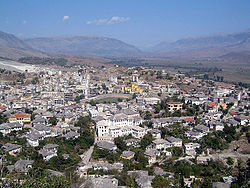 |
|
 Gjirokastër
|
|
| Coordinates: | |
| Country | |
| County | Gjirokastër County |
| District | Gjirokastër District |
| Government | |
| - Mayor | Flamur Bime |
| Elevation | 300 m (984 ft) |
| Population (2009)[1] | |
| - Total | 43,095 |
| Time zone | Central European Time (UTC+1) |
| - Summer (DST) | CEST (UTC+2) |
| Postal code | 6001-6003 |
| Area code(s) | 084 |
| Car Plates | GJ |
| Website | www.gjirokastra.org |
Gjirokastër is a city in southern Albania with a population of around 43,000. Lying in the historical region of Epirus, it is also the capital of both the Gjirokastër District and the larger Gjirokastër County. Its old town is inscribed on the World Heritage List as "a rare example of a well-preserved Ottoman town, built by farmers of large estate." Gjirokastër is situated in a valley between the Gjerë mountains and the Drino River, at 300 meters above sea level. The city is overlooked by the Gjirokastër Castle.
In the 14th and beginning of the 15th century the city was the capital of the Principality of Gjirokastër, under Gjon Zenebishi, before falling under the Ottoman Empire. After the Ottoman defeat in the Balkan Wars and the subsequent withdrawal of the Greek Army, it became again a capital, this time of the short lived Autonomous Republic of Northern Epirus. Gjirokastër is also the city of birth of former Albanian communist leader Enver Hoxha and notable writer Ismail Kadare. It also hosts the Eqerem Çabej University.
Although the majority of the population is Albanian, the city is also home to an ethnic Greek community, as well as to communities of Vlachs and Roma. Gjirokastër is considered the center of the Greek community in Albania[2].
Contents |
Name
The name of the city appears for the first time in historical records under the name of Argyrocastron as mentioned by John VI Kantakouzenos in 1336.[3] The theory that the city took the name of the Princess Argjiro, a legendary figure on whom Ismail Kadare wrote a poem in the 1960s does not have any basis on historical documents and is considered a local legend, since the princess is said to have lived later, in the 15th century.[4] The definite Albanian form of the name of city is Gjirokastra while in the Gheg Albanian dialect it is known as Gjinokastër.[5] In Aromanian the city is known as Ljurocastru, while in Greek as Αργυρόκαστρο (Argyrokastro). During the Ottoman era the town was also known in Turkish as Ergiri.
History
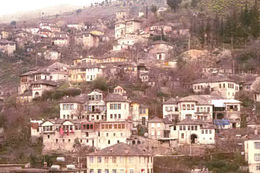
In antiquity, the area around Gjirokastër was inhabited by the Greek tribe of the Chaonians.
The city's walls date from the 3rd century AD. The high stone walls of the Citadel were built, instead from the 6th to the 12th century.[6]
The city developed into a major commercial center known as Argyropolis (Ancient Greek: Αργυρόπολις, meaning "Silver City") or Argyrokastron (Ancient Greek: Αργυρόκαστρον, meaning "Silver Castle").
It was part of the Byzantine Despotate of Epirus in the 13 and 14th century with an autonomous period being the capital of the Principality of Gjirokastër under Gjon Zenebishi. In 1417 it became part of the Ottoman Empire. It was captured in 1811 by the Albanian-born Ali Pasha, who carved out his own semi-autonomous fiefdom in the southwestern Balkans. In the late 19th century, the city was the capital of the sandjak of Ergiri in the Yanya vilayet.
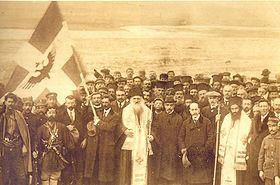
Given its large Greek population, the city was claimed and taken by Greece during the First Balkan War of 1912–1913, following the retreat of the Ottomans from the region.[7] However, it was awarded to Albania under the terms of the Treaty of London of 1913 and the Protocol of Florence of 17 December 1913[8]. This turn of events proved highly unpopular with the local Greek population, and their representatives under Georgios Christakis-Zografos formed the "Panepirotic Assembly" in Gjirokastër in protest.[9] The Assembly, short of incorporation with Greece, demanded either local autonomy or an international occupation by forces of the Great Powers for the districts of Gjirokastër, Saranda, and Korçë.[10] Finally, in March 1914 the Autonomous Republic of Northern Epirus was declared in Gjirokastër and was confirmed by the Great Powers with the Protocol of Corfu[11]. The Republic, however, was short-lived, as Albania collapsed at the beginning of the First World War.[12] The Greek military returned in October-November 1914, and again captured Gjirokastër, along with Saranda and Korçë. In April 1916, the territory referred to by Greeks as Northern Epirus, including Gjirokaster, was annexed to Greece. The Paris Peace Conference of 1919 restored the pre-war status quo, essentially upholding the border line decided in the 1913 Protocol of Florence, and the city was again returned to Albanian control.[13]
In April 1939, Gjirokastër was occupied by Italy and was annexed to that country along with the rest of Albania. During the Second World War, the Greek Army entered the city in 1940 and stayed for a brief six months period, before capitulating to the Germans and returning the city to Italian command. After Italy's capitulation Germany invaded and took control in September 1943, but the city returned to Albanian control in 1944.
The postwar Communist regime developed the city as an industrial and commercial centre. It was elevated to the status of a "museum town",[14] birthplace of the Communist leader of Albania, Enver Hoxha, who had been born there in 1908. His house was converted into a museum.[15]
Gjirokastër suffered severe economic problems following the end of communist rule in 1991. It was particularly badly affected by the 1997 collapse of a massive pyramid scheme which destabilised the entire Albanian economy. The city became the focus of a rebellion against the government of Sali Berisha and violent anti-government protests took place which eventually forced Berisha's resignation. On December 16, 1997, Hoxha's house was damaged by unknown (but presumably anti-communist) attackers, but subsequently restaured.[16]
| Historic Centres of Berat and Gjirokastra* | |
|---|---|
| UNESCO World Heritage Site | |
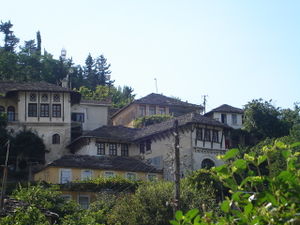 |
|
| State Party | |
| Type | Cultural |
| Criteria | iii, iv |
| Reference | 569 |
| Region** | Europe and North America |
| Inscription history | |
| Inscription | 2005 (29th Session) |
| Extensions | 2008 |
| * Name as inscribed on World Heritage List. ** Region as classified by UNESCO. |
|
Economy
Gjirokastër is principally a commercial center with some industries, notably the production of foodstuffs, leather, and textiles.
Landmarks
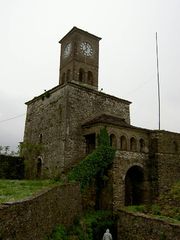
The city is built on the slope surrounding the citadel, located on a dominating plateau.[14] Although the city's walls were built in the third century and the city itself was first mentioned in the 12th century, the majority of the existing buildings date from 17th and 18th centuries. Typical houses consist of a tall stone block structure which can be up to five stories high. There are external and internal staircases to surround the house and it is thought that such design stems from fortified country houses typical in southern Albania. The lower storey of the building contains a cistern and the stable. The upper storey is composed of a guest room and a family room containing a fireplace. The upper stories are to accommodate extended families and are connected by internal stairs.[14]
Many houses in Gjirokastër have a distinctive local style that has earned the city the nickname "City of Stone", because most of the old houses have roofs covered with stones. The city, along with Berat, were among the few Albanian cities that were preserved in the 1960s and 1970s from modernizing building programs. Both cities gained the status of "museum town" and are UNESCO World Heritage sites.[14]
The Gjirokastër Castle dominates the town and overlooks the strategically important route along the river valley. It is open to visitors and contains a military museum featuring captured artillery and memorabilia of the Communist resistance against German occupation, as well as a captured United States Air Force plane to commemorate the Communist regime's struggle against the imperialist powers. Additions were built during the 19th and 20th centuries by Ali Pasha of Tepelene and the Government of King Zog. Today it possesses five towers and houses a clock tower, a church, water fountains, horse stables, and many more amenities. The northern part of the castle was eventually turned into a prison by Zog's government and housed political prisoners during the communist regime.
Gjirokastër also features an old Ottoman bazaar which was originally built in the 17th century, but which had to be rebuilt in the 19th century after it burned down. There are more than 200 homes preserved as "cultural monuments" in Gjirokastër today. The Gjirokastër Mosque dominates the bazar and was built in 1757.[17]
When the town was first proposed for inscription on the World Heritage List in 1988, ICOMOS experts were nonplussed by a number of modern constructions which detracted from the old town's appearance. The historic core of Gjirokastër was finally inscribed in 2005, 15 years after its original nomination.

Religion
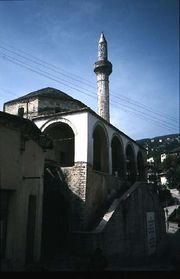
The city has historically had 15 mosques, and in 1945 13 of them were functional.[17] Out of the 13 mosques only the Gjirokastër Mosque has survived and the remaining 12 were destroyed or closed during the Cultural Revolution that the communist government applied in 1967.[17]
The city is also home to an Eastern Orthodox diocese, part of the Orthodox Church of Albania.
Culture
17th century Ottoman traveller Evliya Çelebi, who visited the city in 1670 described the city in detail. During a Sunday Çelebi noticed the big noise of the ongoing vajtim, the typical Albanian lament of the dead performed by a professional: the traveller found the city so noisy during that day because of the vajtims, that he dubbed Gjirokastër the city of wailing.[18]
The novel Chronicle in Stone of the Albanian writer Ismail Kadare tells the history of this city during the Italian and Greek occupation in World War I and II and expands on the customs of the people of Gjirokastër. The first female Albanian writer, Musine Kokalari, instead, wrote at the age of twenty-four, a 80-page collection of ten youthful prose tales in her native Gjirokastrian dialect: As my old mother tells me (Albanian: Siç me thotë nënua plakë), Tirana, 1941. The book tells the day-by-day struggles of women of Gjirokastër, and the prevailing mores of the region.[19]
Gjirokastër is home to the National Folklore Festival (Albanian: Festivali Folklorik Kombëtar) that has held every five years, starting from 1968[20] and most recently in 2009, in its 9th season.[21] It is also where the newspaper Laiko Vima, is published. Founded in 1945, it was the only printed media allowed in the Greek language during the Socialist People's Republic of Albania.[22]
Education
The city is home to the Eqerem Çabej University, which opened its doors in 1968. The university has recently been experiencing low enrollments and, as a result, during the 2008-2009 academic year, the departments of Physics, Mathematics, Biochemistry and Kindergarten Education did not function.[23]
In 2006, the establishment of a Greek-language university in Gjirokastër was agreed upon after discussions between the Albanian and Greek governments [24]. The program had an attendance of 35 students as of 2010, but was abruptly suspended when the University of Ioannina in Greece refused to provide teachers for the 2010 schoolyear and the Greek government and the Latsis foundation withdrew funding.[23]
The first school in the city, a Greek language school, was erected in the city at 1663, sponsored by local merchants, functioned under the supervision of the local bishop. In 1821, when the Greek War of Independence broke up, it was destroyed, but it was reopenned 9 years later, in 1830.[25][26] In 1727 a madrasah started to function in the city, and it worked uninterruptedly for 240 years until 1967, when it was closed due to the Cultural Revolution applied in communist Albania.[17] In 1861-1862 a female school was founded, which was financially supported by the local benefactor Christakis Zografos.[27]
The first Albanian school of Gjirokastër was Drita School, which opened in 1908. Today Gjirokastër has seven grammar schools, two general high schools, and two professional high schools.
Sports
Football (soccer) is popular in Gjirokastër: the city hosts Luftëtari Gjirokastër, a club founded in 1929. The club has competed sometimes in international tournaments and played in the Albanian Superliga until 2006-2007. Currently the team plays in the Albanian First Division. The soccer matches are played in the Subi Bakiri Stadium, which can hold up to 8,500 spectators.[28]
Demographics
The town only has around 43,000 inhabitants.[1] Gjirokastër is home to an ethnic Greek community that was about 4000 in 1989, as well as of communities of Vlachs and Roma.[29][30] Gjirokastër is considered the center of the Greek community in Albania[2].
Notable people

- Ali Alizoti Albanian politician in late 19th century
- Fejzi Alizoti interim Prime Minister of Albania in 1914
- Anastasios Argyrokastritis revolutionary of the Greek War of Independence.
- Kyriakoulis Argyrokastritis (-1828), revolutionary of the Greek War of Independence.
- Subi Bakiri, World War II hero.
- Elmaz Boçe, signatory of the Albanian Declaration of Independence and politician;
- Eqrem Çabej, linguist and ethnologist
- Rauf Fico, politician.
- Bashkim Fino, politician and former Prime Minister of Albania
- Gregory IV of Athens, Albanian scholar and Archbishop of Athens.
- Dimitrios Hatzipolyzoy[31], 19th century merchant
- Altin Haxhi, famous international soccer player, capped in the Albania national team
- Veli Harxhi, signatory of the Albanian Declaration of Independence and politician
- Enver Hoxha, Former first Secretary of the Albanian Party of Labor, and leader of Communist Albania.
- Javer Hurshiti, military commander in the Vlora War
- Feim Ibrahimi, composer
- Ismail Kadare, novelist, winner of the Man Booker International Prize in 2005 and Prince of Asturias Award in 2009.
- Rasim Kalakula,[32] Albanian politician
- Xhanfize Keko movie director
- Saim Kokona, cinematographer
- Musine Kokalari, author
- Eqrem Libohova, former Prime Minister of Albania
- Sabit Lulo, politician
- Bule Naipi, WWII People's Heroine of Albania
- Behxhet Nepravishta[33] Albanian politician from the village of Nepravishta
- Omer Nishani, Head of State of Albania in 1944-1953 period
- Bahri Omari,[34] Albanian politician
- Jani Papadhopulli, signatory of the Albanian Declaration of Independence and politician
- Xhevdet Picari, commander in the Vlora War
- Pertef Pogoni [35] Albanian politician
- Baba Rexheb, Bektashi Sufi religious leader and saint
- Mehmet Tahsini, politician and professor
- Çerçiz Topulli 20th century Albanian nationalist and freedom fighter
- Bajo Topulli, brother of Çerçiz, Albanian nationalist and freedom fighter
- Takis Tsiakos (1909–1997), poet.
- Alexandros Vasileiou (1760–1818), merchant and scholar.
- Michael Vasileiou, brother of Alexandros, merchant.
See also
- List of cities in Albania
- History of Albania
- Geography of Albania
References
- ↑ 1.0 1.1 Instat of Albania (2009). "Population by towns" (in Albanian). Institute of Statistics of Albania. http://www.instat.gov.al/graphics/doc/tabelat/Treguesit%20Sociale/Popullsia/POP%202009/t4%20.xls. Retrieved 19 August 2010.
- ↑ 2.0 2.1 "The Greek minority in Albania in the aftermath of communism, James Pettifer, Defense Academy of the United Kingdom, pp.11-12 "The concentration of ethnic Greeks in and around centres of Hellenism such as Saranda and Gjirokastra..."
- ↑ GCDO History part. "History of Gjirokaster" (in Albanian). Organizata për Ruajtjen dhe Zhvillimin e Gjirokastrës (GCDO). http://www.gjirokastra.org/albanian/al_sublinks/per_gjirokastren/mbi_gjirokastren_historia.html. Retrieved 1 September 2010.
- ↑ Sinani, Shaban; Kadare, Ismail; Courtois, Stéphane (2006) (in French). Le dossier Kadaré. Paris: O. Jacob,. p. 37. http://books.google.com/books?id=JU5xFjzMnq8C&pg=PA37&lpg=PA37&dq=Angelocastro+gjirokaster&source=bl&ots=TyA9_snOQY&sig=U5g3FPmVe_yI8xgWZNVU8h7Lpag&hl=en&ei=0gh9TJjGOoSClAex54HxCg&sa=X&oi=book_result&ct=result&resnum=2&ved=0CBkQ6AEwAQ#v=onepage&q&f=false.
- ↑ The New Encyclopaedia Britannica: Micropaedia. Encyclopaedia Britannica. 1993. p. 289. ISBN 0852295715. http://books.google.com/books?id=ID4uAAAAMAAJ&q=Gjinokaster+%2B+Gheg&dq=Gjinokaster+%2B+Gheg&hl=en&ei=On19TILEDqaWOKLVyYIE&sa=X&oi=book_result&ct=result&resnum=3&ved=0CDIQ6AEwAg.
- ↑ Wilson, Wesley (1997). Countries & Cultures of the World: The Pacific, former Soviet Union, & Europe. Professional Press. p. 149. ISBN 1570873038. http://books.google.com/books?id=TWojAQAAIAAJ&q=City+of+Stone+gjirokaster&dq=City+of+Stone+gjirokaster&cd=4. Retrieved 2010-06-13.
- ↑ Pettifer, J. "The Greek minority in Albania in the aftermath of communism", Defense Academy of the United Kingdom, p. 4 [1]
- ↑ Dimitri Pentzopoulos, The Balkan Exchange of Minorities and Its Impact on Greece, p. 28. C. Hurst & Co, 2002. ISBN 1850656746
- ↑ Valeria Heuberger, Arnold Suppan, Elisabeth Vyslonzil (1996) (in German). Brennpunkt Osteuropa: Minderheiten im Kreuzfeuer des Nationalismus. Oldenbourg Wissenschaftsverlag. p. 68. ISBN 9783486561821. http://books.google.com/books?hl=el&id=edAu3dxEwwgC&q=nordepirus#v=onepage&q=panepirotische%20versammlung&f=false.
- ↑ Ference Gregory Curtis. Chronology of 20th-century eastern European history. Gale Research, Inc., 1994, ISBN 9780810388796, p. 9.
- ↑ Winnifrith, Tom (2002). Badlands-borderlands: a history of Northern Epirus/Southern Albania. London: Duckworth. p. 130. ISBN 0715632019.
- ↑ Contested Spaces and Negotiated Identities in Dhermi/Drimades of Himare/Himara area, Southern Albania. Nataša Gregorič Bon. Nova Gorica 2008. Pg. 140 Formation of the Albanian Nation-State and the Protocol of Corfu (1914)
- ↑ Vassilis Nitsiakos, Constantinos Mantzos, "Negotiating Culture: Political Uses of Polyphonic Folk Songs in Greece and Albania", p. 197 in Greece and the Balkans: Identities, Perceptions and Cultural Encounters, ed. Demetres Tziovas. Ashgate Publishing, Ltd, 2003. ISBN 0754609987
- ↑ 14.0 14.1 14.2 14.3 Petersen, Andrew (1994). Dictionary of Islamic architecture. Routledge. p. 10. ISBN 0415060842. http://books.google.com/books?id=t5gOAAAAQAAJ&pg=PA10&dq=City+of+Stone+gjirokaster&hl=en&ei=GmgVTOTLGML78AazjrGdDA&sa=X&oi=book_result&ct=book-thumbnail&resnum=2&ved=0CDIQ6wEwAQ#v=onepage&q=City%20of%20Stone%20gjirokaster&f=false. Retrieved 2010-06-13.
- ↑ Murati, Violeta. "Tourism with the Dictator" (in Albanian). Standard. http://www.standard.al/index.php/kulture/9952.html. Retrieved 19 August 2010.
- ↑ Lajmi (22 March 2010). "Tourism with the Communist Symbols" (in Albanian). Gazeta Lajmi. http://www.gazetalajmi.com/index.php?option=com_content&view=article&id=387:turizem-me-simbolet-e-komunizmit&catid=106:reportazh&Itemid=438. Retrieved 19 August 2010.
- ↑ 17.0 17.1 17.2 17.3 GCDO. "Regjimi komunist në Shqipëri" (in Albanian). Organizata për Ruajtjen dhe Zhvillimin e Gjirokastrës (GCDO). http://www.gjirokastra.org/albanian/al_sublinks/per_gjirokastren/mbi_gjirokastren_vite_komunizmi.html. Retrieved 1 September 2010.
- ↑ Elsie, Robert (2000). A dictionary of Albanian religion, mythology, and folk culture. New York University Press. pp. 95–96. ISBN 0814722148. http://books.google.com/books?id=aAtQZ0vjf5gC&pg=PA95&dq=vajtim&hl=en&ei=8rsPTPinN8rnnQen1Yi4DQ&sa=X&oi=book_result&ct=book-thumbnail&resnum=7&ved=0CEIQ6wEwBg#v=onepage&q=vajtim&f=false. Retrieved 2010-06-09.
- ↑ Wilson, Katharina M. (March 1991). An Encyclopedia of continental women writers. 2. Taylor & Francis, Inc.. pp. 646. ISBN 0824085477. http://books.google.com/books?id=2Wf1SVbGFg8C&pg=PA646&dq=Musine+Kokalari&hl=en&ei=BBDSS-CVL4L58AbcmuHhDw&sa=X&oi=book_result&ct=book-thumbnail&resnum=10&ved=0CFsQ6wEwCQ#v=onepage&q=Musine%20Kokalari&f=false.
- ↑ Ahmedaja, Ardian; Haid, Gerlinde (2008). European voices: Multipart singing in the Balkans. 1. Wien : Böhlau. http://books.google.com/books?id=Iga91qAoeDYC&pg=PA241&dq=festivali+i+folklorit+gjirokaster+5+years&cd=1#v=onepage&q&f=false.
- ↑ Top Channel (25 September 2009). "Gjirokaster, starton Festivali Folklorik Kombetar" (in Albanian). Top Channel. http://lajme.shqiperia.com/lajme/artikull/iden/315338/titulli/Gjirokaster-starton-Festivali-Folklorik-Kombetar. Retrieved 31 August 2010.
- ↑ Valeria Heuberger, Arnold Suppan, Elisabeth Vyslonzil (1996) (in German). Brennpunkt Osteuropa: Minderheiten im Kreuzfeuer des Nationalismus. Oldenbourg Wissenschaftsverlag. p. 71. ISBN 9783486561821. http://books.google.com/books?id=edAu3dxEwwgC&hl.
- ↑ 23.0 23.1 Μπρεγκάση Αλέξανδρος. "Πάρτε πτυχίο… Αργυροκάστρου". Ηπειρωτικός Αγών. http://www.agon.gr/news/117/ARTICLE/3547/2009-10-24.html. Retrieved 2010-08-31.
- ↑ Country Report on Human Rights Practices in Albania, 2006. U.S. Department of State.
- ↑ Epirus, 4000 years of Greek history and civilization. M. V. Sakellariou. Ekdotike Athenon, 1997. ISBN 9789602133712, p. 308
- ↑ Albania's Captives. Pyrrhus J. Ruches. Argonaut, 1965. p. 33 "At a time of almost universal ignorance in Greece, in 1633, it opened the doors of its first Greek school. Sponsored by Argyrocastran merchants in Venice, it was under the supervision of Metropolitan Callistus of Dryinoupolis."
- ↑ Epirus, 4000 years of Greek history and civilization. M. V. Sakellariou. Ekdotike Athenon, 1997. ISBN 9789602133712, p. 308
- ↑ Worldstadiums. "Stadia in Albania". http://www.worldstadiums.com/europe/countries/albania.shtml. Retrieved 3 August 2010.
- ↑ Human rights in post-communist Albania, Fred Abrahams, Human Rights Watch, p.119 "About 4,000 Greeks live in Gjirokastër out of a population of 30,000.
- ↑ About Gjirokastra, gjirokastra.org
- ↑ Albania's captives. P. J. Ruches. Argonaut, 1965, p.33.
- ↑ Late Ottoman society: the intellectual legacy By Elisabeth Özdalga page 329 [2]
- ↑ Late Ottoman society: the intellectual legacy By Elisabeth Özdalga page 316 [3]
- ↑ Late Ottoman society: the intellectual legacy By Elisabeth Özdalga page 315 [4]
- ↑ Late Ottoman society: the intellectual legacy By Elisabeth Özdalga page 322 [5]
Sources
- "Gjirokastër." Encyclopædia Britannica,2006
- "Gjirokastër or Gjinokastër." The Columbia Encyclopedia (2004)
External links
- Website of Gjirokastra
- Photo Gallery of Gjirokastër from Hotel Kalemi
- Photos of Gjirokastër
- Photo gallery by Andy Carvin
- Gjirokastra Online by Klodian Lula & SIFE UGJ
|
|||||||
|
|||||||||||||||||
|
|||||||
|
|||||||||||
